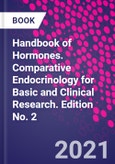Handbook of Hormones: Comparative Endocrinology for Basic and Clinical Research, Second Edition presents a catalog of fundamental information on the structure and function of hormones from basic biology to clinical use, offering a rapid way to obtain specific facts about the chemical and molecular characteristics of hormones, their receptors, signaling pathways, and the biological activities they regulate. The book's stellar editorial board, affiliated with the Japan Society for Comparative Endocrinology, brings together authors that present a compelling structure of each hormone with a consistent presentation that provides a primer surrounding the plethora of hormones that now exist.
Comparative endocrinology continues to rapidly expand and new information about hormones is being produced almost daily, making it important to stay up-to-date. Hormone, paracrine, and autocrine factors have been identified as key players in a range of different systems, including immune, musculoskeletal and cardiovascular. Frontiers between disciplines are being blurred and many scientists in fields other than endocrinology are interested in hormones. Scientists now have the unprecedented opportunity to look from invertebrates to vertebrate and identify novel regulatory factors and understand their function and how they determine an organism's physiology and survival.
Please Note: This is an On Demand product, delivery may take up to 11 working days after payment has been received.
Table of Contents
PART I PEPTIDES AND PROTEINS IN VERTEBRATES
Molecule Evolution of Peptide and Protein Hormones in Vertebrates
Section I.1. Neuropeptides
1. RFamide Peptide Family; 2. Corticotropin-Releasing Hormone Family; 3. Gonadotropin-Releasing Hormone; 4. Thyrotropin-Releasing Hormone; 5. Somatostatin/Neuronostatin; 6. Neurohypophysial hormone family; 7. Opioid Peptide Family; 8. Agouti Family; 9. Tachykinin Family; 10. Appetite-Regulating Peptides; 11. Urotensin II; 12. Neurotensin; 13. Neuromedin U/S /Precursor-related peptide; 14. Neuropeptide S; 15.� Neuropeptide W; 16. Neuroendocrine Regulatory Peptide; 17. Neurosecretory peptide GL/GM; 18. Nesfatin-1;�19. Mexneurin;�20. Phoenixin
Section I.2. Adenohypophysial Hormones
21. Glycoprotein Hormone Family; 22. Growth Hormone/Prolactin Family; 23. Proopiomelanocortin Family
Section I.3. Gastrointestinal Hormones
24. Glucagon Family; 25. Secretin (Pituitary Adenylate Cyclase-Activating Polypeptide) Family; 26. Insulin Family; 27. Gastrin Family;�28. Ghrelin_Motilin Family; 29. Bombesin-Like Peptide Family; 30. Guanylin Family; 31. Galanin Peptide Family; 32. Neuropeptide Y Family; 33. Chromogranin A/Pancreastatin;�34. Xenin
Section I.4. Parathyroid Gland, Ultimobranchial Gland, and Stannius Corpuscle Hormones
35. Parathyroid Hormone Family; 36. Calcitonin/Calcitonin Gene-Related Peptide Family; 37. Stanniocalcin; 38 Cytokines; 39 Hematopoietic growth factors; 40 Cell proliferation factors; 41 Neurotrophins
Section I.6. Other Peripheral Hormones
42. Renin-Angiotensin System; 43. Kallikrein-Kinin System; 44. Apelin; 45. ELABELA; 46. Natriuretic Peptide Family; 47. Gonadal Hormones; 48. Adipocyte Hormones; 49. Endothelin; 50. Irisin; 51. Osteopontin; 52. Osteocrin; 53. Hepcidin/Liver-expressed antimicrobial peptide 1; 54. Salusin; 55. Adropin; 56. Lipocalin-2
PART II PEPTIDES AND PROTEINS IN INVERTEBRATES
Section II.1. Neuropeptides Related to Vertebrate Hormones
57. Gonadotropin-Releasing Hormone-Like Peptide Family; 58. Corticotropin-Releasing Factor-Like Peptide; 59. Oxytocin/Vasopressin Superfamily; 60. Neuropeptide F; 61. Short Neuropeptide F; 62. RYamide; 63. Tachykinin-Like Peptide Family; 64. Insulin Superfamily; 65. Sulfakinin; 66. Cionin; 67. Ci-Galanin-Like Peptide; 68. Allatostatin-C; 69. Calcitonin-like Diuretic Hormone; 70. Ascidian calcitonin; 71. Amphioxus calcitonin family peptide; 72. Achinoderm calcitonin family peptide
Section II.2. Invertebrate-Unique Peptides
73. FXPRLamide Peptide Family; 74. Crustacean Hyperglycemic Hormone; 75. Ion Transport Peptide; 76. Prothoracicotropic Hormone; 77. Bursicon; 78. Allatotropin; 79. Allatostatin-A; 80. Adipokinetic Hormone; 81. Neuroparsin; 82. Ovary Maturating Parsin
Subsection II.2.2 Regulation of Myo/Cardio-Activities
83. LF Peptides; 84. Invertebrate Kinins; 85. FMRFamides; 86. Myoinhibiting Peptide; 87. Myosuppressin; 88. Proctolin;�89. Orcokinins;�90. Crustacean Cardioactive Peptide;�91. Cardioacceleratory Peptide 2b;�92. Achatina Cardio-Excitatory Peptide-1; 93. Fulicins;�94. Buccalins; 95. Eisenia Inhibitory Pentapeptides; 96. GGNG Peptides
Subsection II.2.3 Regulation of Behaviors
97. Eclosion Hormone; 98. Ecdysis Triggering Hormone; 99. Sex Peptide; 100. APWGamide; 101. SIFamide; 102. Egg-Laying Hormone
Subsection II.2.4 Other Hormones and Neuropeptides
103. Growth Blocking Peptide; 104. Yamamarin; 105. CCHamide; 106. Corazonin; 107. Trypsin-Modulating Oostatic Factor; 109. Pigment Dispersing Hormone; 110. GLWamide; 111. Hym-176; 112. Hym-301; 113. Leech Osmoregulatory Factor; 114. Ciona YFV/L peptide
PART III LIPOPHILIC HORMONES IN VERTEBRATES
115. Thyroid Hormones; 116. Gonadal Steroids; 117. Corticosteroids; 118. Neurosteroids; 119. Vitamin D Derivatives
PART IV LIPOPHILIC HORMONES IN INVERTEBRATES
120. Ecdysteroids; 121. Juvenile Hormone; 122. Methyl Farnesoate
PART V ENDOCRINE DISRUPTING CHEMICALS
123. Endocrine Disruptors; 124. Anti-Thyroid Hormone Active Chemicals
PART VI Amines and Amino Acids
125 Amines; 126 Amino Acids; 127 Acetylcholine
PART VII GASOTRANSMITTERS
128. Gasotransmitter Family
Authors
Hironori Ando Marine Biological Station, Sado Island Center for Ecological Sustainability, Niigata University, Japan. Sado Marine Biological Station, Faculty of Science, Niigata University, Niigata, Japan. His specific research interest involves neuroendocrine regulation of behavioral and physiological functions in diadromous migratory fish, such as salmonids and puffer fish. Kazuyoshi Ukena Graduate School of Integrated Sciences for Life, Hiroshima University, Japan. Graduate School of Integrated Arts and Sciences, Hiroshima University, Hiroshima, Japan.Professor Ukena discovered NPGL, a brain chemical that regulates hunger and fat storage in mammals, shows that hunger and energy consumption mechanisms are even more complex than we realized and has broad clinical and societal implications for the study and treatment of obesity and its associated diseases. Shinji Nagata Graduate School of Frontier Science, The University of Tokyo, Japan. Graduate School of Frontier Science, The University of Tokyo, Chiba, Japan. His research interests incluces regulatory mechanisms of feeding behavior in insects at a molecular level. In the laboratory, they use insects to understand the underlying strategies used by animals to survive. A number of the techniques and devices required for such investigation are available for use, including the purification of biologically active compounds, protein and peptide purification, molecular cloning, intracellular signaling, and bioimaging.








